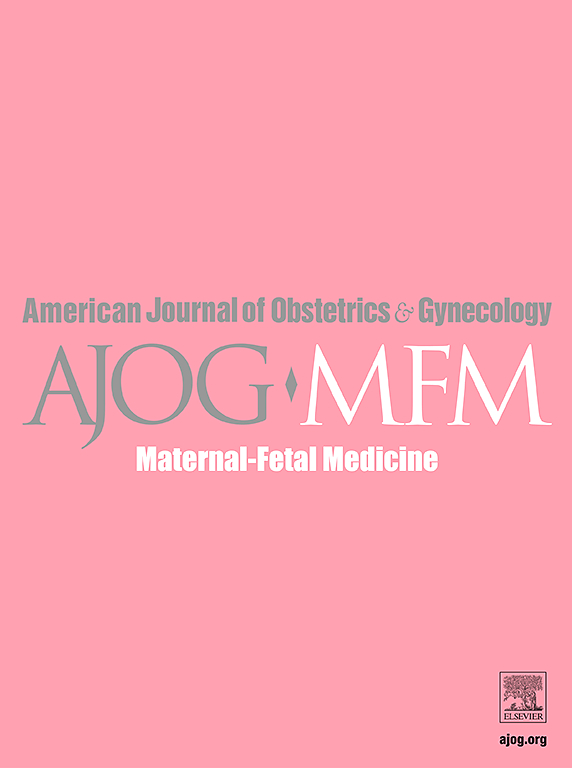Cesarean delivery, labor duration, and mothers’ mortality risk over 50 years of follow-up
IF 3.8
2区 医学
Q1 OBSTETRICS & GYNECOLOGY
American Journal of Obstetrics & Gynecology Mfm
Pub Date : 2024-09-19
DOI:10.1016/j.ajogmf.2024.101498
引用次数: 0
Abstract
Background
Pregnancy complications have been recognized as a window to future health. Though cesarean delivery is common, it is unknown whether labor duration and mode of delivery are associated with maternal long-term mortality.
Objective
To examine whether labor duration and mode of delivery were associated with all-cause and cause-specific mortality.
Study Design
Participants were mothers from the multisite Collaborative Perinatal Project (CPP) cohort (1959–1966; n=43,646, limited to last CPP delivery). We ascertained all-cause and specific causes of death as of 2016 via linkage to the National Death Index and Social Security Death Master File. Hazard ratios (HR) testing mode of delivery and labor duration were estimated using Cox proportional hazards models adjusted for demographic and clinical characteristics. We further stratified analyses by parity.
Results
Among participants with a recorded delivery mode, 5.9% (2486/42,335) had a cesarean delivery. Participants who had a cesarean were older (26.9 vs 24.3 years), with higher body mass index (24.0 vs 22.7 kg/m2), were less likely to be nulliparous (21% vs 30%), and more likely to have a household income of at least $6000 (22% vs 17%), to smoke ≥1 pack/d (18% vs 15%), to have diabetes mellitus (12% vs 1%) and to have a prior medical condition (47% vs 34%), compared to participants with a vaginal delivery. Delivery mode was similar by race/ethnicity, marital status, and education. Median labor duration was 395 minutes among participants who had an intrapartum cesarean delivery and 350 minutes among participants delivered vaginally. By 2016, 52.2% of participants with a cesarean delivery and 38.5% of participants with a vaginal delivery had died. Cesarean vs vaginal delivery was significantly associated with increased risk for all-cause mortality (HR=1.16 (95% confidence interval [CI]: 1.09, 1.23); in nulliparas, HR=1.27 (95% CI: 1.09, 1.47); in multiparas, HR=1.13 (95% CI: 1.06, 1.21) as well as increased risk of death from cardiovascular disease, diabetes, respiratory disease, infection, and kidney disease. Associations with death from cardiovascular disease, infection, and kidney disease were stronger for multiparas than nulliparas, though the association with death from diabetes was stronger among nulliparas. Labor duration was not significantly related to overall mortality.
Conclusion
In a historic United States cohort with a low cesarean delivery rate, cesarean delivery was an indicator for subsequent increased mortality risk, particularly related to cardiovascular disease and diabetes. Future studies with long-term follow-up are warranted given the current high prevalence of cesarean delivery.
剖腹产、产程和 50 年随访期间母亲的死亡风险:剖腹产和产妇死亡率。
背景:妊娠并发症被认为是未来健康的窗口。虽然剖宫产很常见,但分娩持续时间和分娩方式是否与孕产妇长期死亡率有关尚不清楚:研究设计:研究设计:参与者为多地点围产期合作项目队列中的母亲(1959-1966 年;n=43646,仅限于围产期合作项目的最后一次分娩)。我们通过与国家死亡指数和社会保障死亡主档案的链接,确定了截至 2016 年的全因死亡和特定死因。检验分娩方式和分娩持续时间的危险比使用考克斯比例危险模型进行估计,并根据人口统计学和临床特征进行调整。我们还进一步按胎次进行了分层分析:在有分娩方式记录的参与者中,5.9%(2486/42335)为剖宫产。与阴道分娩的参试者相比,剖宫产的参试者年龄更大(26.9 岁对 24.3 岁),体重指数更高(24.0 公斤对 22.7 公斤/平方米),更不可能是无阴道分娩(21% 对 30%),更有可能家庭收入至少为 6000 美元(22% 对 17%),吸烟≥1 包/天(18% 对 15%),患有糖尿病(12% 对 1%)和曾有过疾病(47% 对 34%)。分娩方式在种族/民族、婚姻状况和教育程度方面相似。剖宫产参与者的中位分娩持续时间为 395 分钟,阴道分娩参与者的中位分娩持续时间为 350 分钟。到 2016 年,52.2% 的剖宫产参与者和 38.5% 的阴道分娩参与者已经死亡。剖宫产与阴道分娩相比,与全因死亡风险增加显著相关(危险比 = 1.16(95% 置信区间:1.09,1.23);无胎儿的危险比 = 1.27(95% 置信区间:1.09,1.47);多胎儿的危险比 = 1.13(95% 置信区间:1.06,1.21)),与心血管疾病、糖尿病、呼吸系统疾病、感染和肾脏疾病死亡风险增加也显著相关。多胎妊娠者死于心血管疾病、感染和肾脏疾病的几率要高于单胎妊娠者,而单胎妊娠者死于糖尿病的几率要高于多胎妊娠者。分娩持续时间与总死亡率无明显关系:结论:在一个剖宫产率较低的美国历史性队列中,剖宫产是随后死亡风险增加的一个指标,尤其是与心血管疾病和糖尿病有关。鉴于目前剖宫产的高流行率,今后有必要进行长期随访研究。
本文章由计算机程序翻译,如有差异,请以英文原文为准。
求助全文
约1分钟内获得全文
求助全文
来源期刊

American Journal of Obstetrics & Gynecology Mfm
Medicine-Medicine (all)
CiteScore
7.40
自引率
3.20%
发文量
254
审稿时长
40 days
期刊介绍:
The American Journal of Obstetrics and Gynecology (AJOG) is a highly esteemed publication with two companion titles. One of these is the American Journal of Obstetrics and Gynecology Maternal-Fetal Medicine (AJOG MFM), which is dedicated to the latest research in the field of maternal-fetal medicine, specifically concerning high-risk pregnancies. The journal encompasses a wide range of topics, including:
Maternal Complications: It addresses significant studies that have the potential to change clinical practice regarding complications faced by pregnant women.
Fetal Complications: The journal covers prenatal diagnosis, ultrasound, and genetic issues related to the fetus, providing insights into the management and care of fetal health.
Prenatal Care: It discusses the best practices in prenatal care to ensure the health and well-being of both the mother and the unborn child.
Intrapartum Care: It provides guidance on the care provided during the childbirth process, which is critical for the safety of both mother and baby.
Postpartum Issues: The journal also tackles issues that arise after childbirth, focusing on the postpartum period and its implications for maternal health. AJOG MFM serves as a reliable forum for peer-reviewed research, with a preference for randomized trials and meta-analyses. The goal is to equip researchers and clinicians with the most current information and evidence-based strategies to effectively manage high-risk pregnancies and to provide the best possible care for mothers and their unborn children.
 求助内容:
求助内容: 应助结果提醒方式:
应助结果提醒方式:


